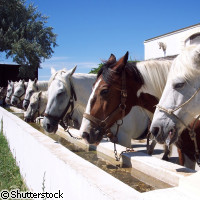Researchers reveal secrets of the white horse
For the first time, the genetic mutation responsible for giving white horses their attractive colour has been identified. An international team led by researchers at Uppsala University in Sweden has not only identified the mutation causing this trait but has also traced the unique gene back to a common ancestor that lived thousands of years ago. The white horse is an icon for dignity which has had a huge impact on human culture across the globe. It serves as an emblem on many state flags, including the state of Lower Saxony of Germany, and frequently appears in literature. They even take centre stage in the famous Spanish Riding School of Vienna, Austria. What many people don't know is that the white horses, such as those appearing in the Spanish Riding School, are not born white, but instead black, or even brown or chestnut, and only turn white when they reach maturity. This transformation process was what the research study focused on. 'It is a fascinating thought that once upon a time a horse was born that turned grey and subsequently white and the people that observed it were so fascinated by its spectacular appearance that they used the horse for breeding so that the mutation could be transmitted from generation to generation,' says Professor Leif Andersson from the Department of Medical Biochemistry and Microbiology at Uppsala University. Today, about 1 horse in 10 carries the mutation for greying with age. The greying process starts during a horse's first year of life. The whole process is usually completely white by six to eight years of age but the skin remains pigmented. While the process resembles greying in humans, it is ultra fast in these horses. The results of the study were published in the online journal Nature Genetics on 20 July. Their findings also have great interest in the area of medical research since this mutation also enhances the risk for melanoma. About 75% of grey horses older than 15 years of age have a benign form of melanoma that in some cases develops into a malignant melanoma. Thus, the study reported today has given new insight into a molecular pathway that may lead to tumour development. What the research team investigated were the cells in the lower level of the skin's epidermis and whether the grey mutation gene overly stimulates the cells that produce melanin, thereby leading to their premature loss. 'We propose that the grey mutation stimulates growth of melanocytes and that this leads to a premature loss of the melanocyte stem cells needed for hair pigmentation whereas the mutation promotes an expansion of some of the melanocytes causing skin pigmentation,' explains Professor Andersson. 'It is very likely that regulatory mutations like the one we found in these white horses constitute the dominating class of mutations explaining differences between breeds of domestic animals as well as between species like humans and chimpanzee,' he concludes.
Countries
Sweden



